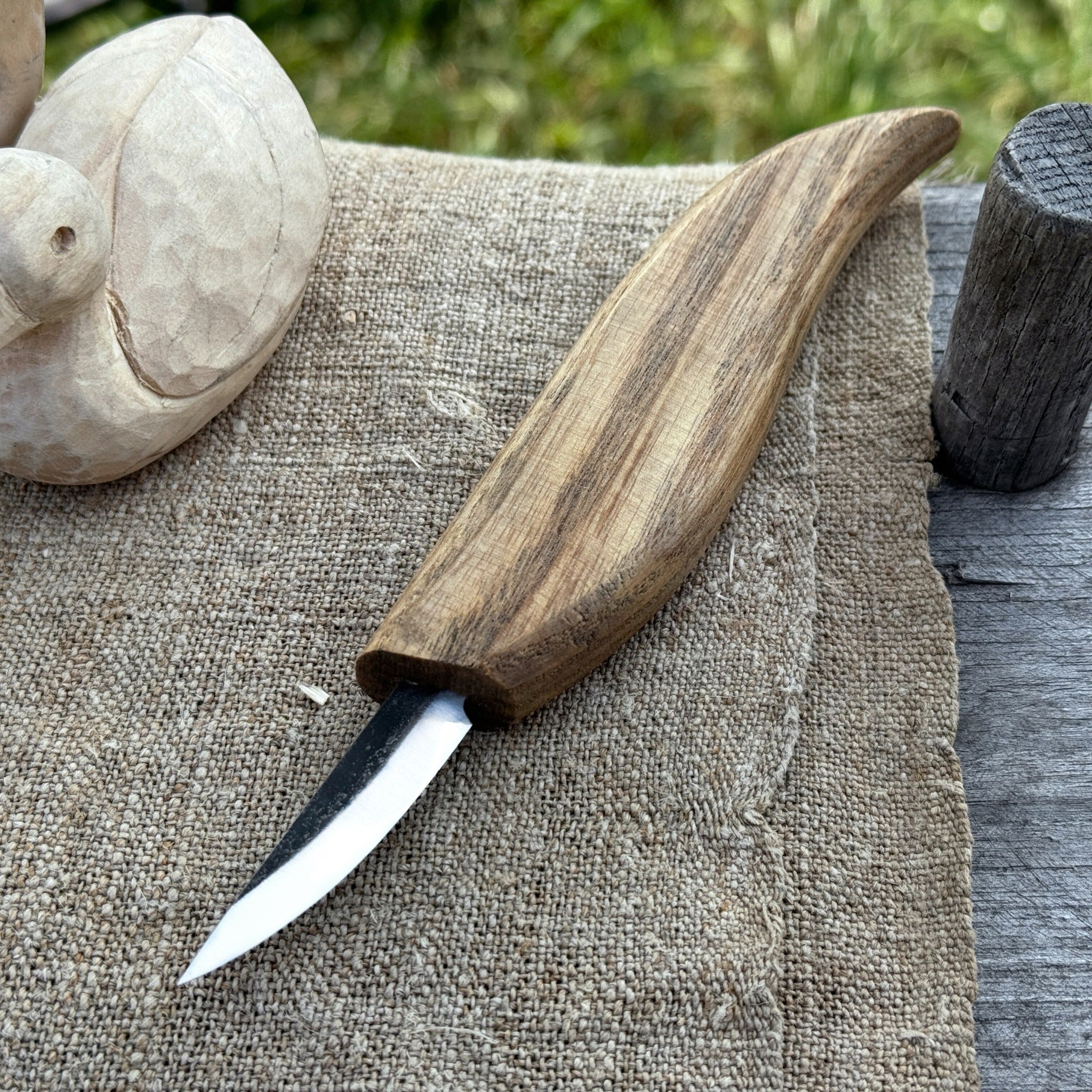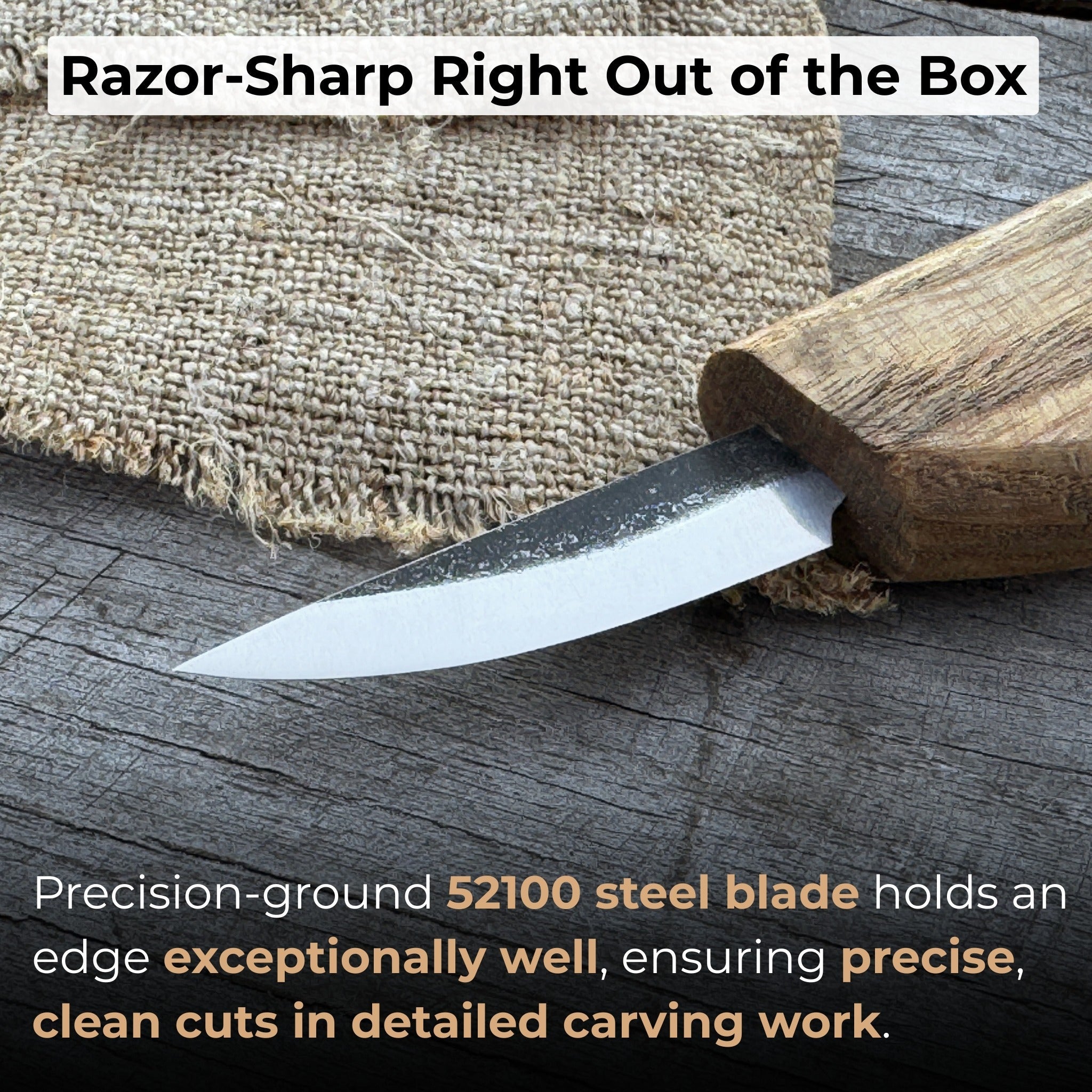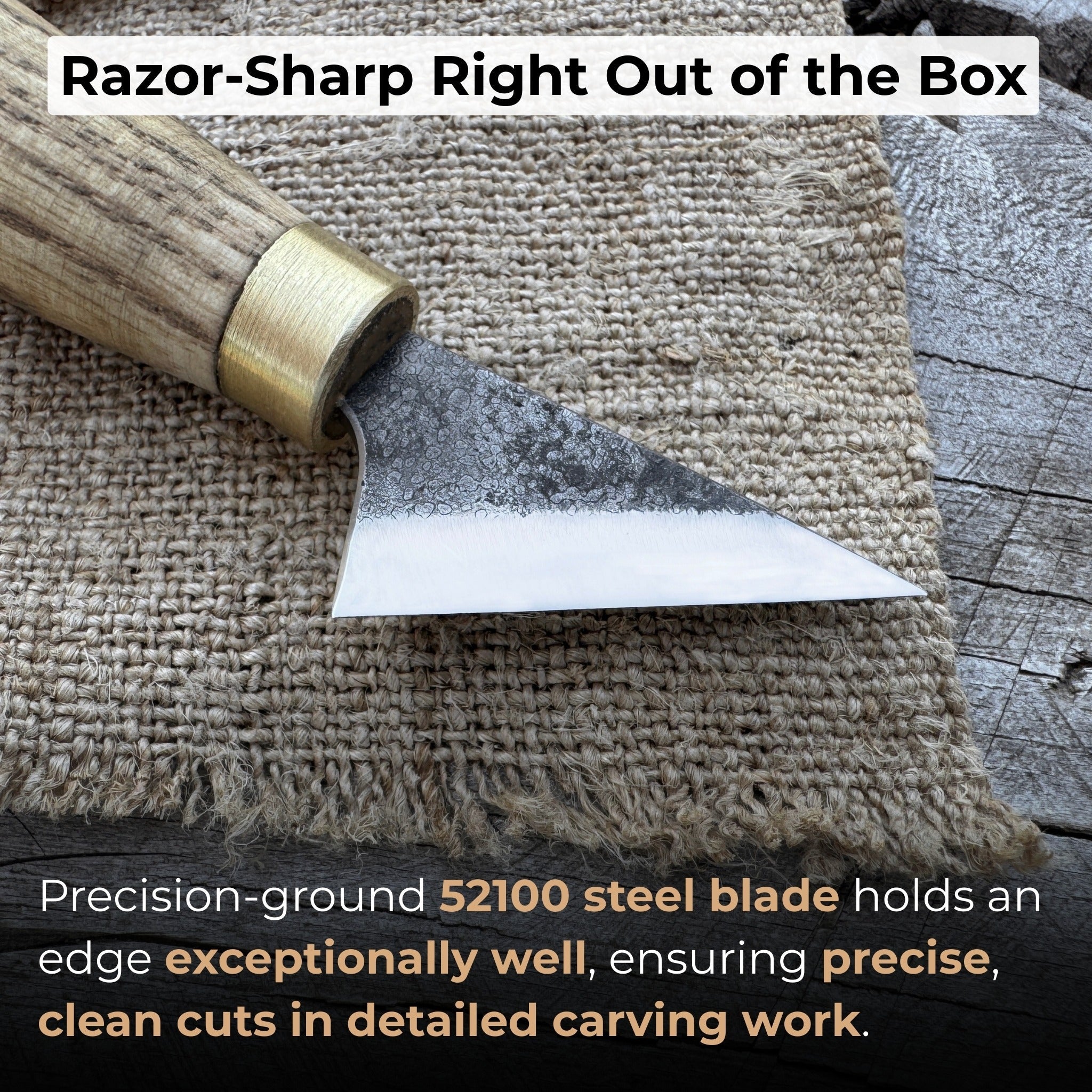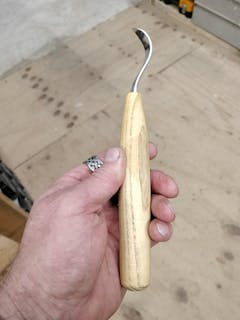Whittling Knife for Wood Carving, 4.5 cm (1.77 inches)
Chip Carving Knife, 3.5 cm (1.4 inches)
Chip Carving Knife, blade 3 cm (1.2 inches)
Hand-Forged Roughing Knife, Blade 5 cm (1.97 inches)
Detail Knife for Wood Carving, 4 cm (1.57 inches)

Small Sloyd Carving Knife, Blade 6.5 cm (2.56 inches)
Small Chip Carving Knife, 3.5 cm (1.38 inches)
Chip Carving Knife, 5.5 cm (2.2 inches)
Importance of Quality Chip Carving Knives
Chip carving is a popular woodworking technique used extensively to create fancy designs on various wooden surfaces. The technique involves cutting away portions of the original panel to create a 3D effect. Decorative furniture, boxes, kitchen tools, and holiday decorations are some of the most common woodworks made with chip carving knives.
Chip carving knives are quite affordable, with prices starting as low as $10-$20. However, cheap wood tools often come with a number of disadvantages. They are often made from lower-grade steel and dull more quickly. They can lose their edge faster and may have some inconsistencies in blade alignment and handle design, which negatively impact the precision and durability of the knife set.
Higher-quality chip knives can cost $50 or more, offering better steel quality and improved ergonomics. Some may also feature thumb notches for better control, making them more attractive to craftsmen.
So, what type of chip carving knife is better, and what qualities make it a good investment? Read on to find out.
Types of Chip Carving Knives
Some expert chip carvers would say that having just one chip carving knife would be enough to do the bulk of the chip carving work. Others might argue that the best chip carving knife set also includes a stab knife, chisels, or gouges. We would add to the list sharpening equipment, drawing instruments, and the wood for practice boards and finished projects.
To simplify your selection process, consider the type of work you want to do first. The styles are very versatile, offering unique aesthetic and functional qualities. Some of the primary styles you may come across are:
- Geometric chip carving: Characterized by repeated geometric patterns.
- Free-form chip carving: Allows freedom of design with cuts of different depth and angle.
- Shallow chip carving: Used on denser woods with shallow cuts.
- Old-world-style chip carving: Also called Swiss chip carving. This method employs shallow cuts, but they are typically longer and larger in size.
Once you have decided on the type of work you want to do and have learnt about the process it involves, proceed to selecting your carving tools set. Below is a short overview of the tools you may want to add to the knife set.
Detail Knives
- Purpose: Used for precise sophisticated cuts, especially for fine details.
- Blade shape: Usually has a pointed tip suitable for intricate designs.
- Usage: Perfect for adding small, delicate drawings to your carvings.
Geometric Knives
- Purpose: Created specifically for geometric patterns.
- Blade shape: Typically has two tips to make cuts in both directions.
- Usage: A great match for repeated, identical geometric patterns like triangles, squares, etc., ensuring high precision.
General Purpose Knives
- Purpose: As the name suggests, it is a good option for a variety of wood projects and is a good starting point for beginners.
- Blade shape: Typically features a straight or slightly curved blade, making it well-suited for roughing out and carving finer details.
- Usage: A good option for those who want a single chip carving knife; it is also a great choice for beginners who want to try different chip carving styles.
Stab Knives
- Purpose: Used for making small, precise stabs (punctures).
- Blade shape: As a rule, have short, pointed blades.
- Usage: Suitable for pressing small designs into the wood and making accents in your carvings.
Cutting Knives
- Purpose: Used for general cutting and shaping.
- Blade shape: Straight and slightly curved.
- Usage: Great for removing larger chunks of wood and making first cuts.
Key Features to Look for in Chip Carving Knives
Looking at a picture of a chipping knife is not enough to judge its quality and durability. You may explore some well-established brands, make a shortlist of their specifications, and then compare them with other brands on the market. Some of the features you should consider include:
Blade Material
One of the key features of a high-end carving tool, which can really make it the best chip carving knife, is steel hardness. This is evaluated by the Rockwell scale. The hardness of a chipping knife's high-carbon steel should be between Rc58-63. Lower values would mean that the blade is too soft to hold the cutting edge needed for accurate chip carving.
Choose the tools made from high-carbon steel to ensure longer sharpness of the carving tool, its durability, and ease of sharpening. Stainless steel blades are more resistant to rust and corrosion, making them more suitable for humid environments, but they may require more frequent sharpening compared to high-carbon steel.
Handle Design
Handle design and material are also very important for your safety and comfort. Wood handles, especially those made from hardwoods like ash, provide a very comfortable grip. Hardwood handles have a long lifespan and are resistant to external damage, while composite handles can be even more durable.
When it comes to the best shape for the chip carving knife handle, expert carvers recommend searching for full tang construction. Full tang refers to how the tool is attached to the handle. In full tang construction, the steel extends through the entire handle, making the chip knife safer.
Sharpness and Edge Retention
When you select a chip carving knife, consider blade shape and size: it should be thin for precise cuts and better control, and also has the length that best suits your project. More detailed works require shorter blades.
Choosing pre-sharpened chip carving knives can be beneficial for beginners. With pre-sharpened tools, you will also know the manufacturer’s standard, which provides a consistent cutting edge.
How to Make Chip Carving More Enjoyable
Now that you have decided on the wood carving kit you need, what else might you consider to make your woodworking a truly enjoyable pastime? Evaluating your skill set and being clear about the progress you want to achieve over time could help a lot.
Starting with simpler wood carving projects and steadily building up your proficiency will help you progress in the future. You may want to practice different techniques at different points in time and then identify areas for improvement.
Practicing geometric techniques will help you start confidently. Use practice boards to hone your skills and then move on to actual chip carving design projects.
Selecting the right wood also makes a big difference. Basswood is considered the best choice for chip carving beginners and professionals. This wood is soft and easy to carve with a chip carving knife. It is quite affordable and holds details well thanks to its smoothness and fine grain. Other good options would be butternut and eastern white pine.
When your experience grows, try harder woods like cherry or walnut to achieve different finishes and textures. Refine your techniques by making more concise cuts with the best chip carving knife you can find. Strive to make cuts symmetrical, expand design complexity, and build up your portfolio. Seek regular feedback to hone your wood carving skill set. Keep your tools sharp and learn about efficient sharpening techniques; this will contribute significantly to your success.
Some Closing Remarks
By continuously challenging yourself, you can take your chip carving to the next level. Try joining woodworking clubs, channels, or groups where fellow carvers would exchange ideas and share valuable experiences. Attend workshops and enroll in classes to stay up to date with the latest trends.





























